Living aquatic plants are an excellent addition to any freshwater aquarium.
The plants take nitrates from the water to use as fertilizer; they absorb carbon dioxide and give off oxygen through photosynthesis, providing shelter and spawning grounds for fish.
Green plants look beautiful in any aquascape, but red aquarium plants add something special to the aesthetics of a tank. Red plants can be challenging to grow, but some are suitable for a beginner’s tank.
Keep reading to discover 17 varieties of red aquarium plants that you’ll love to add to your fish tank.
17 Beautiful Red Aquarium Plants for Every Home Tank
Our 17 favorite red aquarium plants can add beauty and variety to any freshwater fish tank.
Rotala rotundifolia
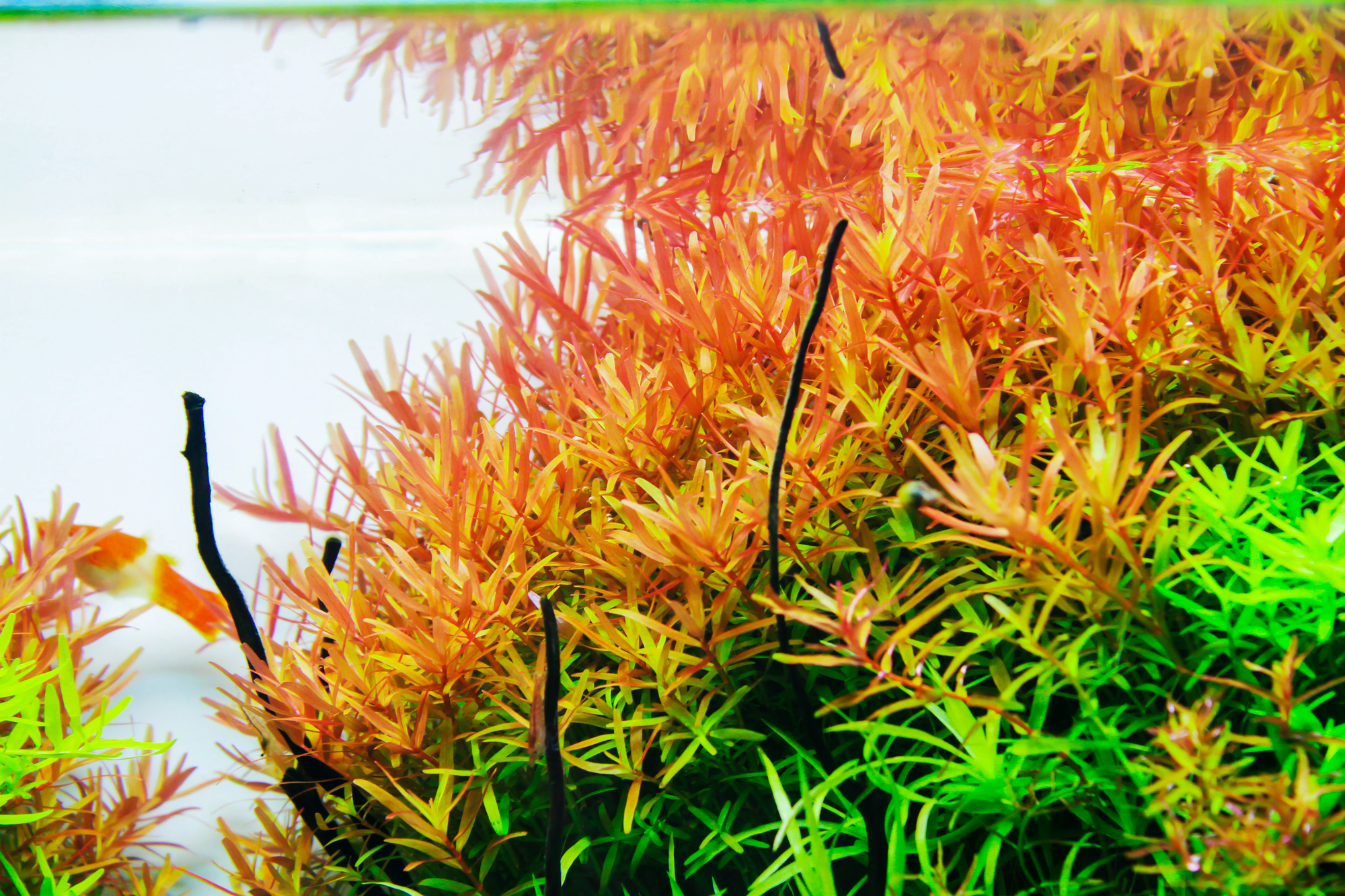
- Light level: High
- Position: Mid-ground to background
- Care: Moderate
Rotala rotundifolia is a popular aquarium plant that comes from Southeast Asia. The plant grows in rice paddies and other wet, marshy terrain, where it grows like a weed.
The plant is relatively easy to grow in the aquarium if you have bright lighting levels in your tank. To enjoy the plant’s colors at their most vivid, you need to provide it with strong lighting. If the lighting is not intense enough, the plant will drop its leaves and lose its red coloring, turning yellow-green.
Rotala rotundifolia works best when paired with other species of low-growing plants in the mid-ground or background of your aquarium. You can also grow the plant to the surface, where it falls in a gorgeous reddish-pink color cascade, creating a divine waterfall effect.
The plant thrives with the correct conditions, so you must prune it frequently.
Alternanthera reineckii
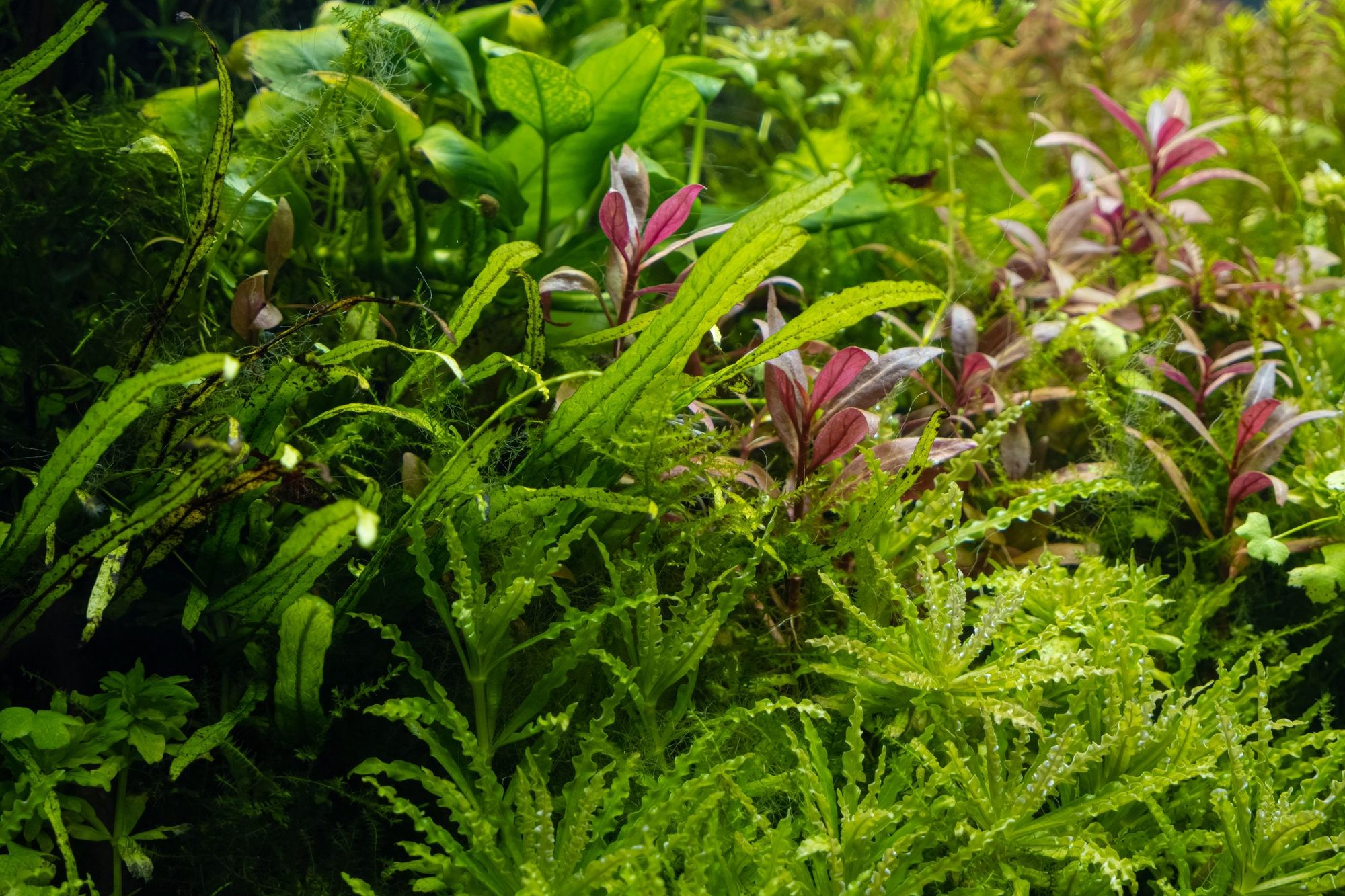
- Light level: Bright, strong lighting is essential
- Position: Surface or background, depending on the variety
- Care: Moderate
Alternanthera reineckii is relatively easy to grow and maintain compared to other red aquarium plant species.
There are several varieties of Alternanthera reineckii to choose from, the most popular being Alternanthera reineckii Rosanervig and Alternanthera reineckii mini.
The mini variety is brighter red in color than other types of this plant and, thanks to its smaller size, is useful as a surface plant. Taller varieties of Alternanthera reineckii, such as Rosanervig and Rosaefolia, are better placed toward the back of the aquarium.
The bushy growth of this plant makes it ideal as a shelter for smaller fish. You can encourage good growth by trimming the plant regularly. Although CO2 isn’t necessary for boosting growth, high-intensity lighting is essential for healthy growth. However, be aware that when using stronger lighting, you must clear algae from the leaves to prevent it from suffocating the plant.
Ludwigia repens
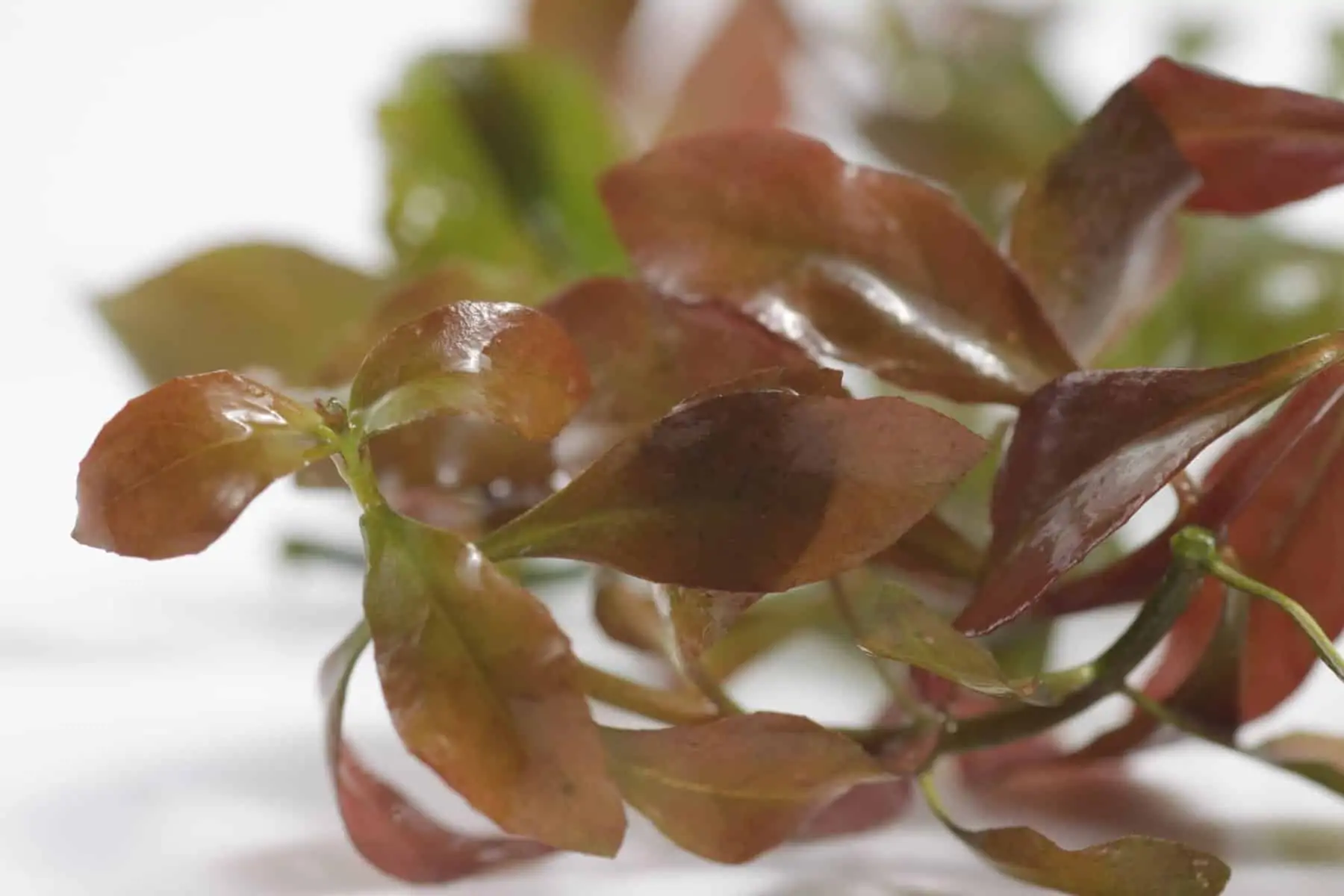
- Light level: Medium lighting
- Position: Mid to background
- Care: Easy, beginner-friendly plant
Ludwigia repens is an excellent choice of classic aquarium plant for beginner hobbyists, as it’s easy to grow and care for and lends itself to pretty much any aquascaping theme. You can find Ludwigia repens readily available in most good fish stores.
Young plants grow best, and you need to give them plenty of time to acclimate to the conditions in your tank. Ludwigia repens propagates quickly, enabling you to populate your whole tank from just a few small plants. So, you don’t need to spend a fortune on a forest, as the plant will fill the tank on its own!
Ludwigia repens is a root feeder. That means you can use the substrate to anchor the plant. However, we recommend using gravel rather than sand as a substrate because sand can stifle and suffocate the plant’s roots. Feed the plant with a liquid or root tab fertilizer to encourage healthy root growth.
Red Tiger Lotus
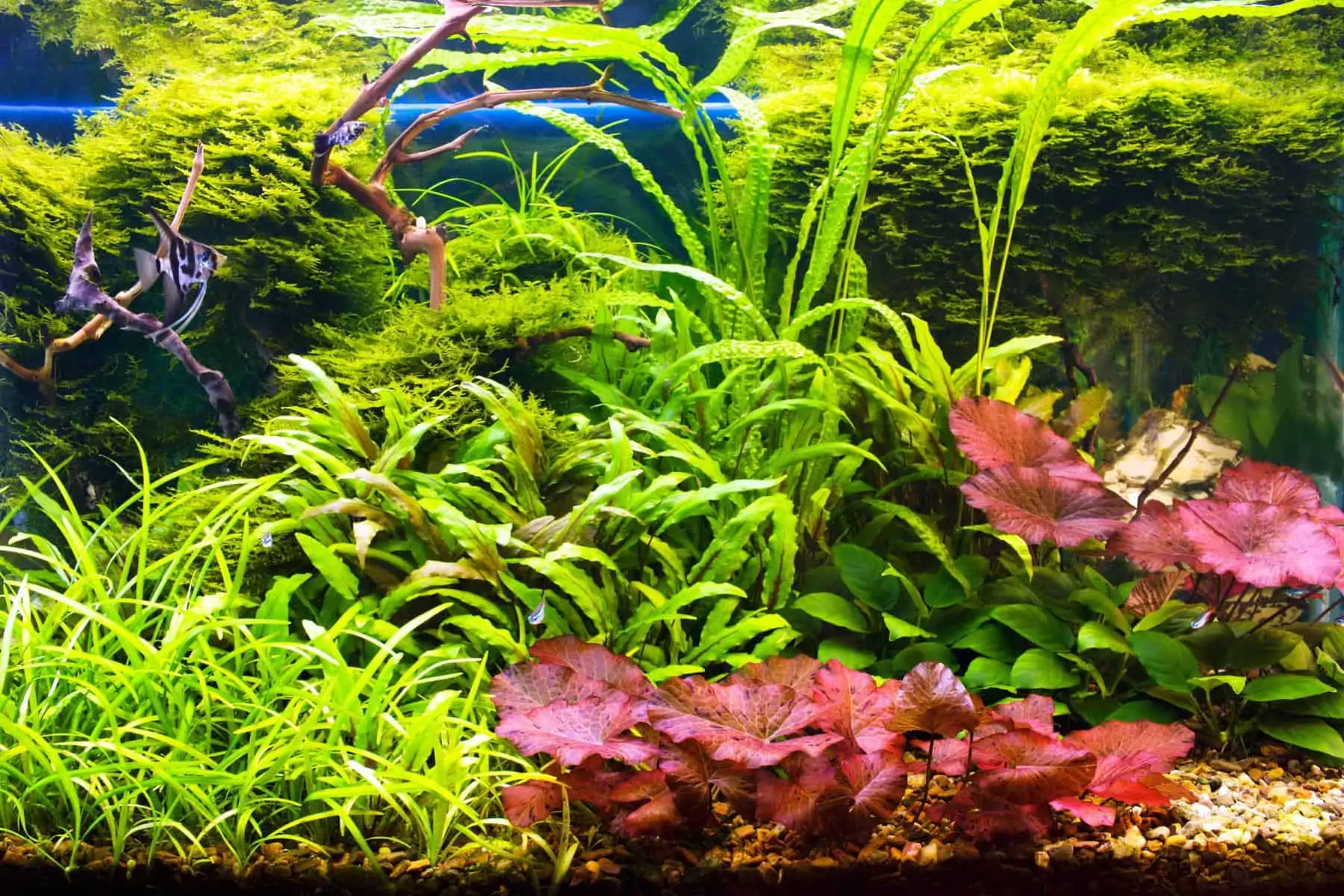
- Light level: High
- Position: Surface
- Care: Easy
Red Tiger Lotus is a popular red-colored aquarium plant from West Africa and Southeast Asia. This hardy plant species is a water lily that grows in shallow, stagnant water, typically alongside other members of the water lily family.
The Red Tiger Lotus has red, arrow-shaped leaves that look stunning when used in larger tanks. This fast-growing plant doesn’t need special care, making it a good choice for beginners. However, you need to limit the plant’s growth by containing its roots, preventing the seeds from spreading, and carrying out frequent trimmings.
You must know that this popular plant needs adequate iron, or the leaves can turn green instead of red. This hungry plant will deprive its neighbors of nutrients if given a chance.
Rotala indica
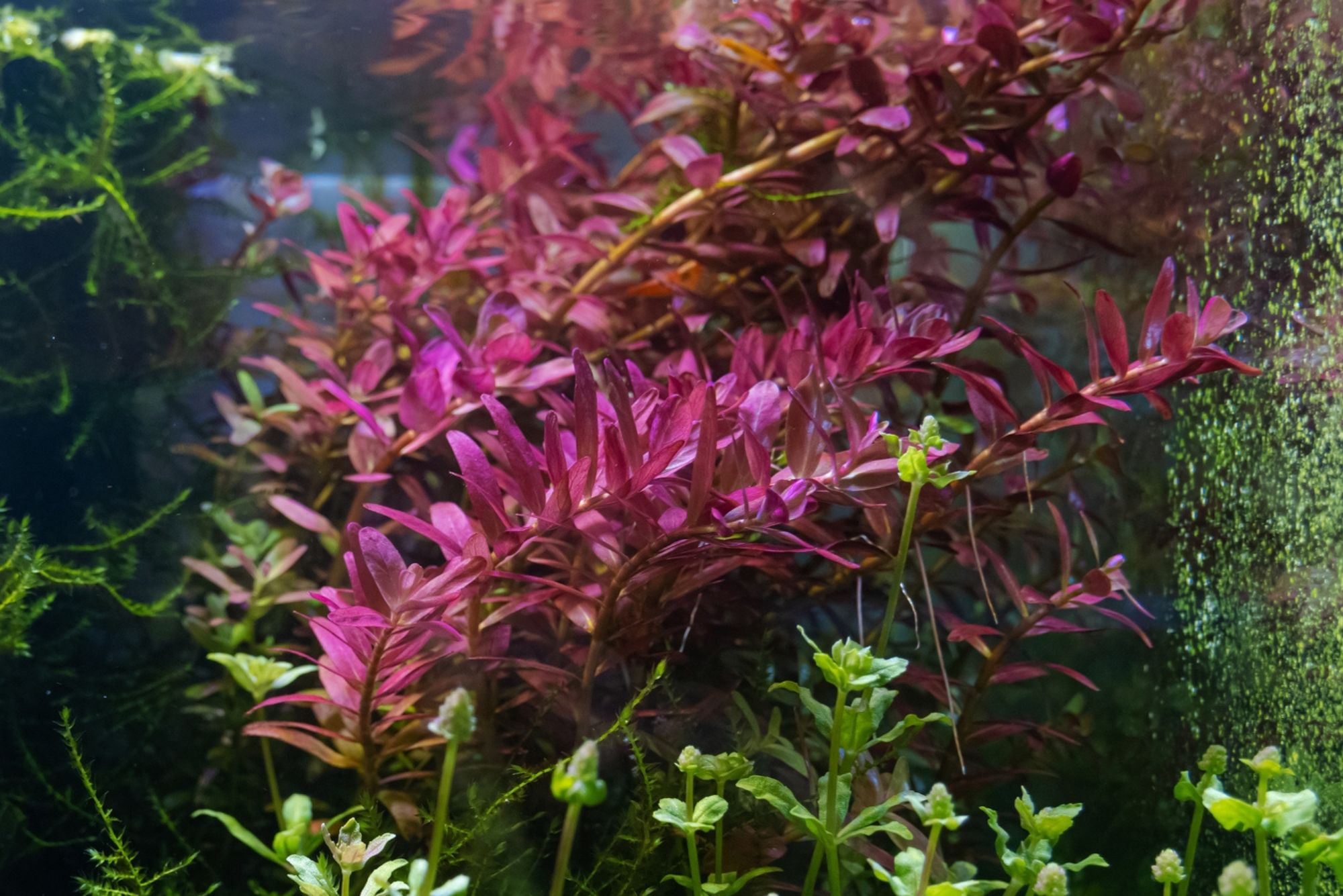
- Light level: Medium
- Position: Mid-ground
- Care: Moderate
Rotala indica, or Indian Toothcup, is a pretty undemanding plant that will tolerate a range of water parameters. This is a good choice if you’re looking for an attractive mid-ground plant for your fish tank.
This versatile plant can be grown across the surface if it gets enough light, iron, trace elements, and CO2. Rotala indica is an annual herbaceous plant that produces flowers and leaves. Rotala indica is quite a fragile plant, so we don’t recommend this plant for aquariums that house large, boisterous fish that might damage the plant’s delicate stems.
Rotala indica overgrows, so it needs regular pruning and thinning out to keep it tidy and be sure it gets enough light. The plant’s compact, bushy habit makes it ideal for use in spawning tanks and those with shy fish species.
Rotala Yao Yai
- Light level: High
- Position: Background
- Care: Moderate
Rotala Yao Yai is not commonly seen in fish stores or home fish tanks. That’s a shame, as this is a very attractive plant that lends itself extremely well to aquascaping.
The plant has a beautiful orange-pinkish tint to its branches and is more vivid in color than other species in the same family.
Rotala Yao Yai needs regular trimming to keep its bushy shape and encourage healthy growth. If the branches become too densely packed, the leaves won’t receive enough light, affecting growth rates and color.
Rotala wallichii
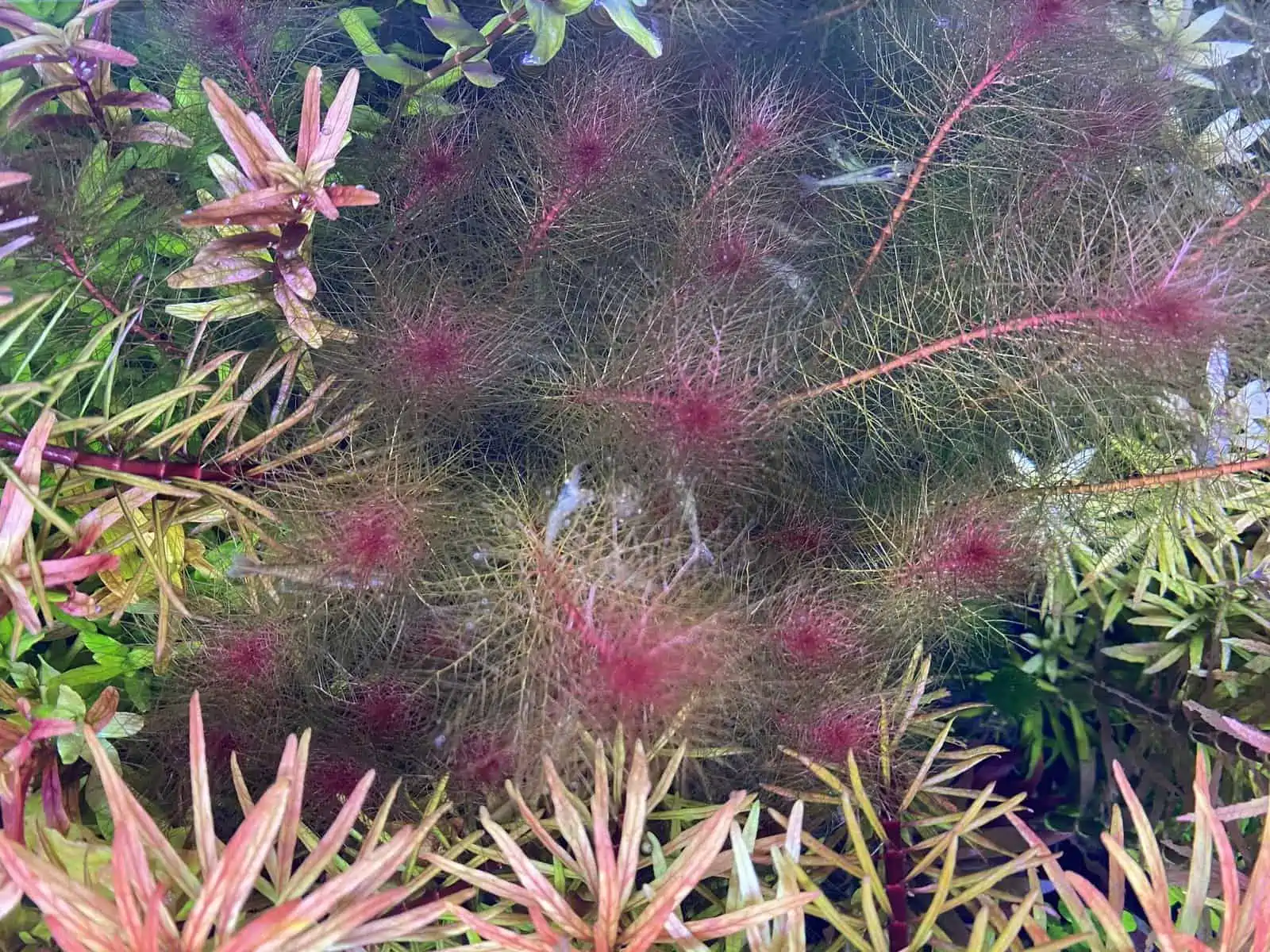
- Light level: High
- Position: Background or mid-ground
- Care: Advanced
Rotala wallichii is a fabulous red aquarium plant that is becoming increasingly popular for aquascaping.
The plant has red and pink stems with needle-shaped leaves. Providing the plant with the optimum growing conditions will reward you with strikingly beautiful flower spikes carrying vibrant purple blooms.
The main issue with growing Rotala wallichii is that it needs lots of light to grow well. In addition, the plant requires support with CO2 injections, nitrate, and iron supplements. Rotala wallichii grows best in tank conditions containing high phosphate levels. However, despite being a tricky customer to grow, this plant is very rewarding when you see taller plants thriving in the background zone of your tank.
To propagate Rotala wallichii, trim off the uppermost shoots and plant them in the substrate. The lateral shoots can also produce new roots when replanted. This plant looks best when displayed at the back or middle of the aquarium.
Rotala macrandra
- Light level: High
- Position: Background or mid-ground
- Care: Advanced
Rotala macrandra is one of the world’s most sought-after, popular aquascaping plants. Unfortunately, this gorgeous, vibrant red plant is not a good choice for a beginner. This demanding plant overgrows and is highly demanding in nutrients.
Rotala macrandra comes in several forms: red, green, narrow leaf, and mini. These beautiful plants demand stable pH levels in the tank, iron, trace elements, and intense lighting for strong growth. Without those requirements, Rotala macrandra won’t grow well or display its flashy colors.
Ludwigia arcuata
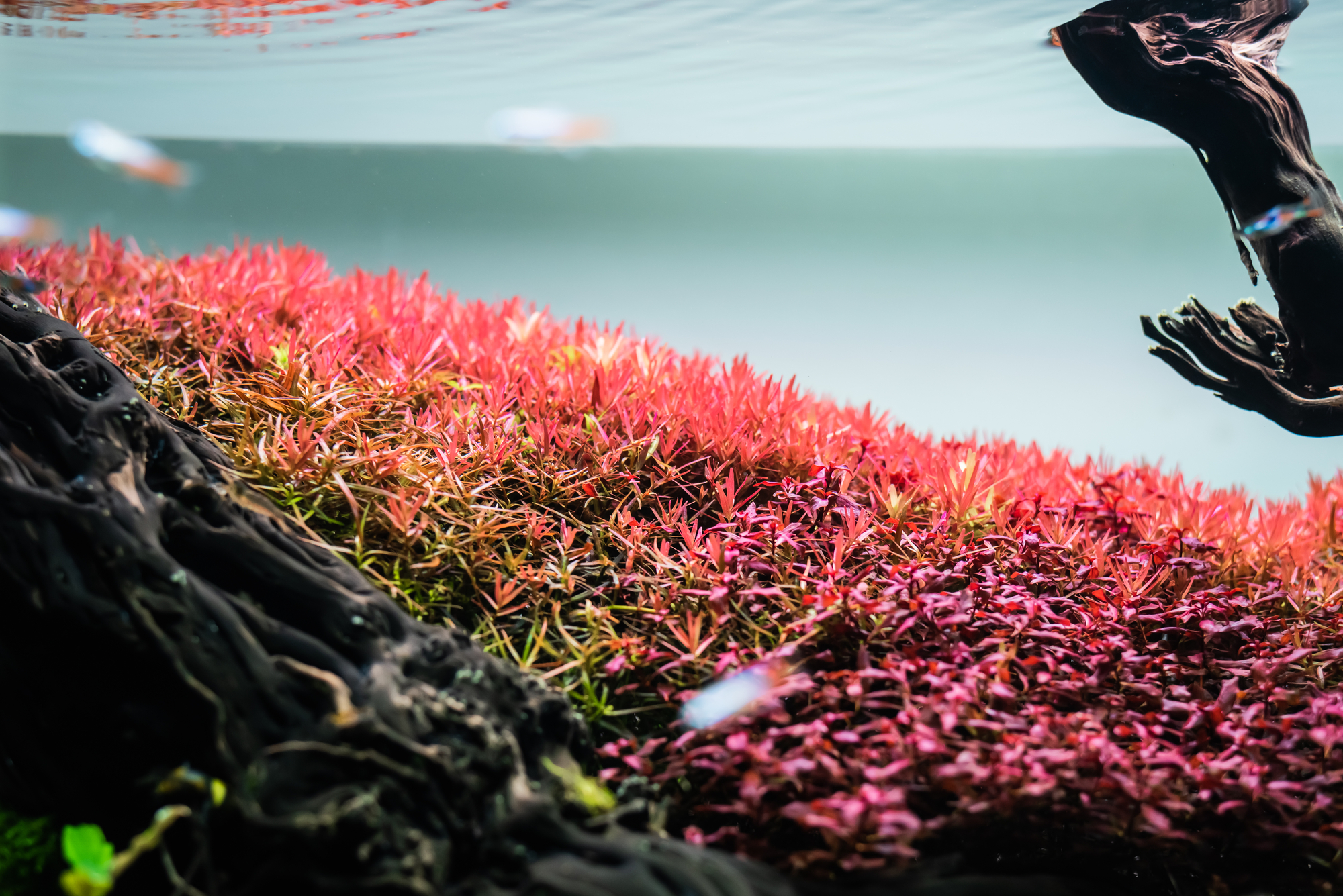
- Light level: High
- Position: Background or mid-ground plant
- Care: Easy, beginner-friendly
Ludwigia arcuata produces green, needle-like leaves that grow on a vivid red stem, adding movement and dimension to your tank.
The leaf color depends on the levels of iron in the water. If you add iron to your aquarium, the plant will grow more vigorously, and its colors will be more vibrant. You need bright lighting to grow this plant, and adding CO2 to your tank will encourage more robust growth.
You can grow Ludwigia arcuata submerged or emersed. However, the plant’s leaves are rounder in shape when grown emersed. When grown underwater with adequate lighting, the plant’s leaves will become thinner in shape and a more orange-red color.
Ludwigia arcuata is slower-growing than other red aquarium plant species but still needs regular trimming regularly to encourage a bushy growth habit. You can encourage more bushy growth by pruning the shoots from the sides.
Lagenandra meeboldii red
- Light level: High
- Position: Mid-ground plant
- Care: Easy, beginner-friendly
Lagenandra meeboldii red is a medium-sized aquatic plant from Southern India, where it grows abundantly.
The plant presents various colors, ranging from bright green to violet, red, and reddish-violet. Sometimes, the leaves can have different colors on the same leaf. The variant most commonly found in aquariums are the red and green ones. When the plant is young, the leaves are green, changing to different colors as the plant grows, depending on the growing conditions.
Lagenandra meeboldii is a useful midground plant thanks to its small size. The plant is relatively slow-growing and undemanding to keep, making this a good choice for a beginner’s aquarium. Be careful not to put the plant in a position where it overshadows its neighbors.
A nutrient-rich substrate can boost the plant’s growth and encourage it to show its true colors, as can using CO2 injection and providing bright light conditions.
Ludwigia palustris

- Light level: High
- Position: Foreground plant
- Care: Easy, beginner-friendly
Ludwigia palustris is a striking plant that can brighten up your aquascape with its vibrant colors without being as challenging to grow as some other colorful aquatic species.
This plant makes an excellent foreground plant if you want to make a statement or focal point in your tank. Ludwigia palustris can be red, orange, or gold, with very intense lighting levels bringing out the plant’s best colors.
You can grow Ludwigia palustris submerged or emersed, although growing the plant emersed is more challenging. Trim the plant’s side shoots to encourage a denser growing habit and propagation.
Barclaya longifolia red
- Light level: Medium
- Position: Background or foreground plant
- Care: Easy, beginner-friendly
Barclaya longifolia red comes from Southeast Asia and belongs to the water lily family. However, unlike other water lilies, this plant grows fully underwater, a trait that makes Barclaya longifolia red ideal as an aquarium plant.
The plant has a medium growth rate and can be grown at the back or front of your tank. Barclaya longifolia red will grow under medium lighting, although strong incandescent lighting will bring out the plant’s bright colors. You can boost the plant’s growth by increasing nutrient levels in the tank, using liquid fertilizers and CO2 injections, although that’s not essential.
Ludwigia glandulosa
- Light level: High
- Position: background plant
- Care: Moderate
Ludwigia glandulosa is a vibrantly colored plant that can make a stunning addition to any aquarium. The plant has beautiful red and purple color leaves and stems that can be used to create a magical focal point in any tropical freshwater tank.
To produce the plant’s best colors, you must provide plenty of intense lighting, a supply of CO2 supplementation, and a nutrient-rich substrate. You also need to keep the water temperatures below 77°F. If you don’t provide Ludwigia glandulosa with enough light, it will drop its leaves, and it could even turn green.
Ludwigia glandulosa will not branch out like many other aquatic plant species once it reaches and breaks the water surface.
Bacopa colorata
- Light level: Low to high
- Position: Mid-ground
- Care: Easy, beginner-friendly
Bacopa colorata comes from the USA and is much less demanding than many other red aquarium plants, making it a good choice for novice aquarists.
The plant’s branches spread from the bottom of the stem, creating a spectacular look. Bacopa colorata grows slowly, making it easy to maintain and keep looking tidy.
Unlike many red aquarium plant species, Bacopa colorata doesn’t need very intense lighting and grows fine in low to medium-light conditions. In fact, normal daylight conditions in your home are sufficient. However, if you can provide bright lighting, the plant’s leaves will produce a more vibrant color.
Proserpinaca palustris
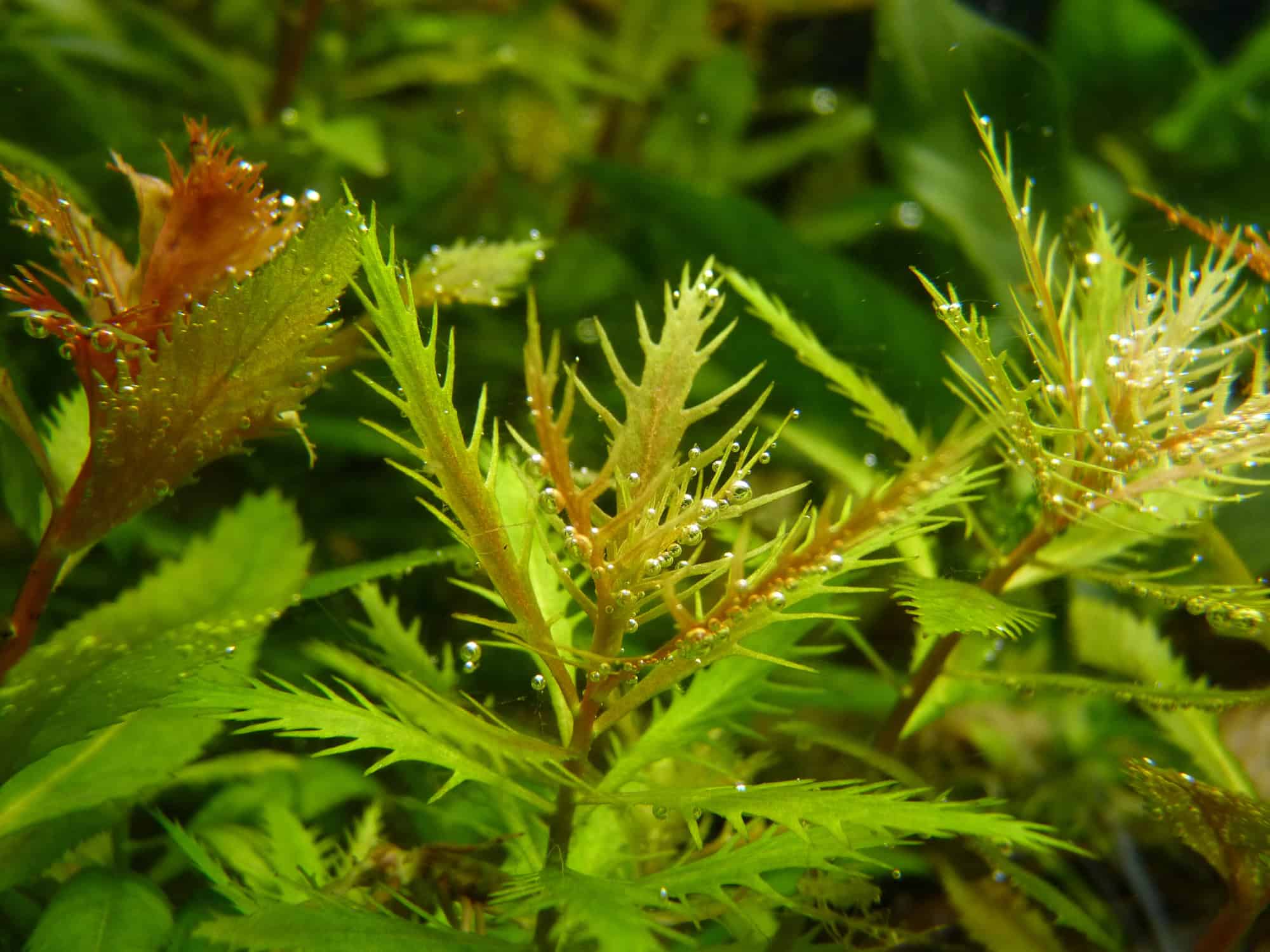
- Light level: High
- Position: Foreground plant
- Care: Moderate
Proserpinaca palustris is also sometimes called Mermaid weed. The herbaceous plant is pretty straightforward to grow, although it can take a while to become acclimated to a new aquarium.
You can grow Proserpinaca palustris, which will assume a saw-toothed form. If you grow the plant submerged, the leaves become orange-red in color. If grown under very high-intensity lights, Proserpinaca palustris’ leaves grow to form tiny, delicate combs.
The plant is slow-growing and needs plenty of light, nutrients, and CO2 to thrive and produce its best colors of pink and gold. The plant will drop its leaves if Proserpinaca palustris is deprived of the nutrients it needs.
Persicaria Sao Paulo
- Light level: High
- Position: Mid-ground
- Care: Moderate
As you probably guessed from its name, Persicaria Sao Paulo comes from Brazil. This excellent midground plant is ideal for most fish tanks, working especially well in contrast with bright green plants.
Persicaria Sao Paulo produces vibrant magenta leaves and a moderate growth rate when provided with ideal growing conditions. The plant is undemanding regarding water parameters and is pretty easy to grow under low to moderate lighting.
To propagate the plant, simply trim the top of the stems and plant them in the substrate.
Myriophyllum tuberculatum red
- Light level: High
- Position: Mid-ground
- Care: Advanced
Myriophyllum tuberculatum red is a difficult plant to grow. The plant comes from Southeast Asia and is also found in Australia.
Myriophyllum tuberculatum’s red feathery leaves have an intense red hue, making this a challenging but beautiful addition to any aquarium. However, you must provide this aquatic plant with optimal growth conditions to thrive. Myriophyllum tuberculatum red needs at least 0.8 watts of lighting per liter of aquarium water. Nitrate and phosphate levels should be 5 to 15 mg/l and 1 to 2 mg/l, respectively.
If the plant doesn’t receive the precise parameters it needs, growth will be seriously retarded. Myriophyllum tuberculatum needs iron and other micronutrients, too, to prevent discoloration and leaf drop. For optimum growth, you need to provide Myriophyllum tuberculatum with CO2 injections.
You need to grow Myriophyllum tuberculatum at the mid-ground or background areas of the tank. If the plant reaches the water’s surface, it will become bushy, so you must ensure that other surrounding plants are not deprived of lighting.
Final Thoughts
I hope you enjoyed our guide to our 17 favorite species of red aquarium plants. If you did, please take a moment to share the article before you dash off to buy some red plants for your tank!
Red aquatic plants make a beautiful focal point and accent in any aquarium. However, many red aquarium plant species are not easy to grow and require additional supplementation and intense lighting conditions to thrive and do well. That said, we have found some red plant species suitable for beginners and relatively low-maintenance.
Do you have red aquarium plants in your tank? What species do you grow? Tell us in the comments box below.


